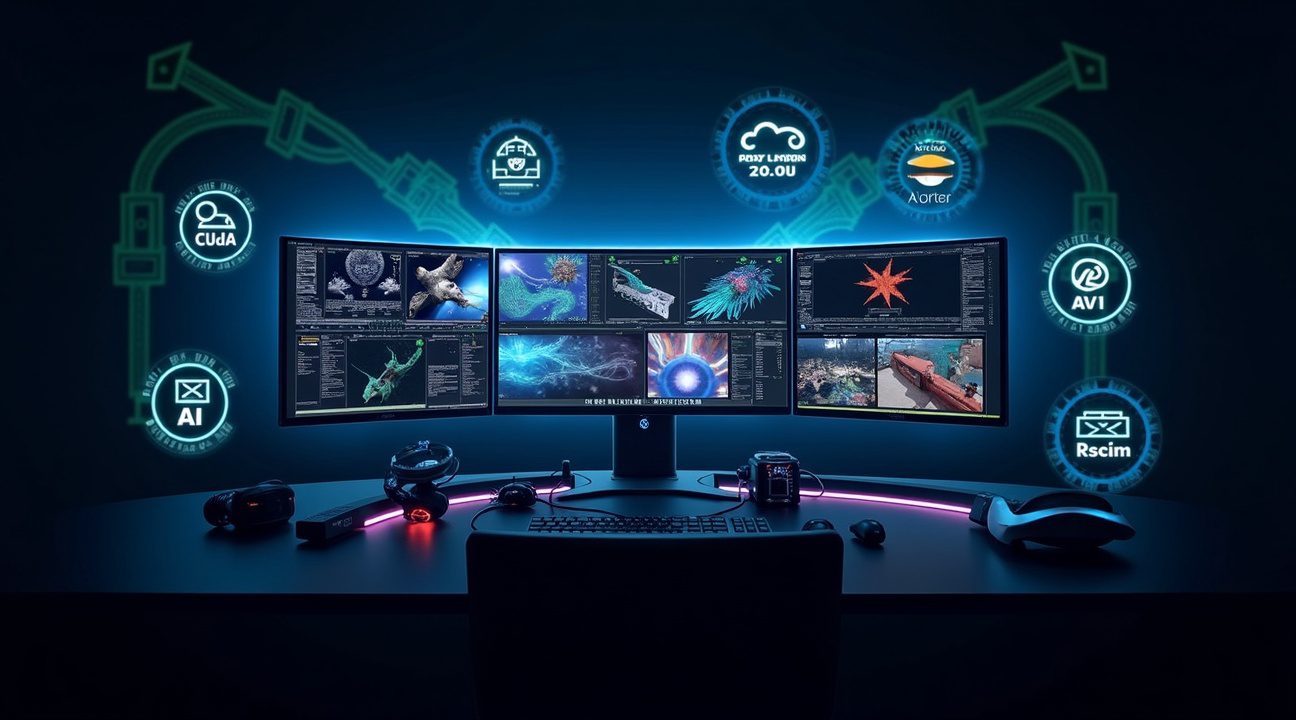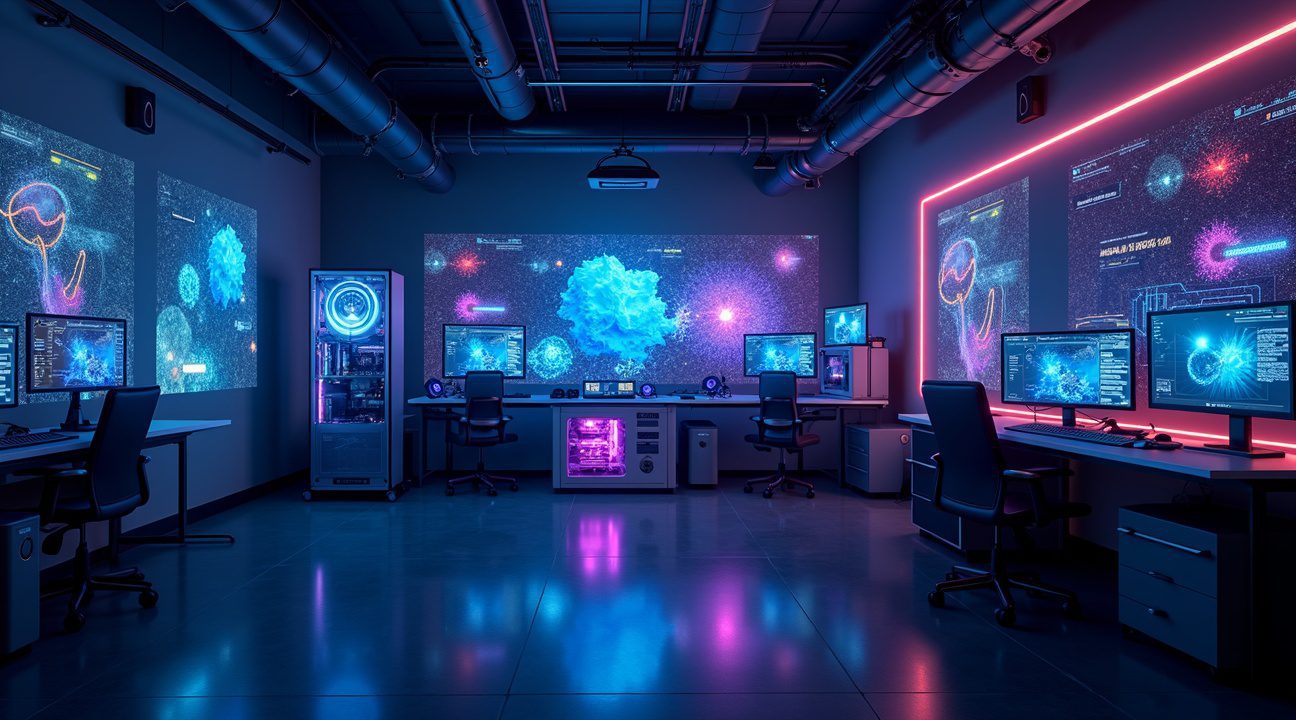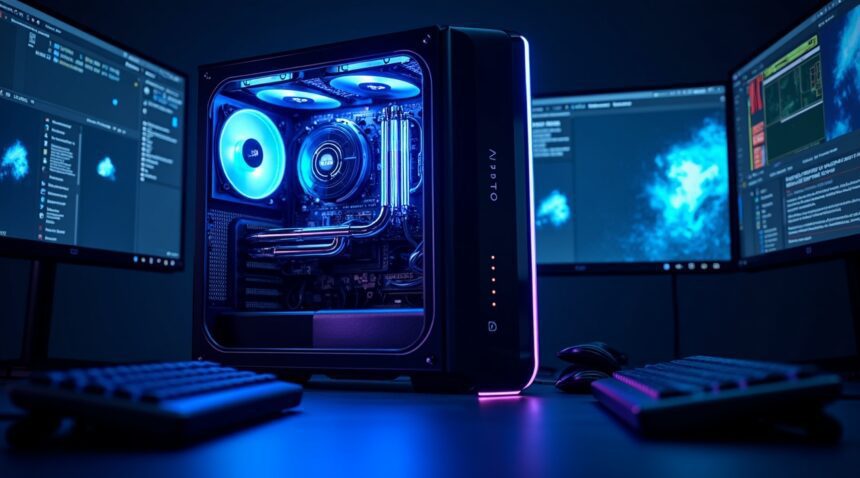PewDiePie has assembled what he terms a “nuclear supercomputer,” integrating eight NVIDIA RTX 4000 Ada Generation GPUs into a staggering multi-GPU workstation that delivers unmatched computing performance and efficiency.
System Overview
This highly customized setup is not only one of the most powerful consumer-accessible machines, but it’s also designed to handle complex, professional tasks such as AI workflows, content creation at ultra-high resolutions, and even scientific computing. With its combined 160GB of ECC GDDR6 memory and massive parallel processing power, the system is essentially a professional data center workstation built into a single rig.
Key Takeaways
- Massive computational power: Eight RTX 4000 Ada GPUs deliver 213.6 TFLOPS for general computing, 494.4 TFLOPS for ray tracing, and over 3.4 petaFLOPS for AI workloads.
- Professional-grade memory: 160GB total ECC GDDR6 memory ensures high stability and allows seamless handling of massive datasets and uncompressed 8K video workflows.
- Efficient single-slot design: Each GPU draws only 130W of power and fits into a single PCIe slot, allowing extensive scalability from four to eight GPUs without requiring additional chassis modifications.
- Comprehensive API support: Compatible with CUDA 12.2, DirectX 12, Vulkan 1.3, and AV1 hardware encoding, making it highly versatile for demanding applications in gaming, AI, and media production.
- Future-proof architecture: Built on the Ada Lovelace architecture, which includes fourth-generation Tensor Cores and third-generation RT Cores, this rig is optimized for future innovations in real-time ray tracing and AI-powered solutions.
Want to learn more?
You can explore more technical specifications and use cases for the NVIDIA RTX 4000 Ada Generation GPUs on the official NVIDIA website.
Eight NVIDIA RTX 4000 Ada Generation GPUs Deliver Unprecedented Power
PewDiePie’s nuclear supercomputer represents a remarkable achievement in computational power, featuring eight NVIDIA RTX 4000 Ada Generation GPUs that transform his workstation into a true computational powerhouse. This massive multi-GPU configuration demonstrates how professional-grade hardware can push the boundaries of what’s possible in content creation and gaming.
Raw Computational Performance Numbers
The eight-card setup delivers staggering performance metrics that place it among the most powerful consumer-grade systems available. The combined computational power includes:
- 213.6 single-precision TFLOPS (FP32) for general computing tasks
- 494.4 TFLOPS dedicated ray tracing performance for realistic lighting and reflections
- Over 3.4 petaFLOPS tensor performance for AI and machine learning workloads
- 160GB total ECC GDDR6 memory across all eight cards
Each individual NVIDIA RTX 4000 Ada Generation GPU contributes 6,144 CUDA cores, 192 Tensor Cores, and 48 RT cores to this computational arsenal. This massive parallel processing capability enables PewDiePie to handle the most demanding video editing tasks, real-time rendering, and streaming operations simultaneously without performance degradation.
The system’s ability to deliver over 3.4 petaFLOPS in tensor performance places it in territory typically reserved for professional data centers and research institutions. Content creators rarely need such extreme computational power, but PewDiePie’s ambitious projects clearly justify this investment. Recent developments in the streaming industry, including Twitch’s various policy changes, have pushed creators to explore new technological frontiers.
Power consumption becomes a critical consideration with eight RTX 4000 Ada cards running simultaneously. Each GPU operates at 130W, creating a combined GPU power draw of 1,040W. This doesn’t include the substantial power requirements for the CPU, motherboard, memory, storage, and cooling systems needed to support such a configuration.
The 160GB of ECC GDDR6 memory across all cards provides unprecedented capacity for handling massive datasets, complex 3D scenes, and multiple high-resolution video streams. ECC (Error-Correcting Code) memory ensures data integrity during long rendering sessions, preventing crashes that could cost hours of work.
Gaming enthusiasts often wonder about thermal management in such extreme configurations. PewDiePie’s nuclear supercomputer likely requires advanced liquid cooling solutions and careful airflow design to maintain optimal temperatures. The RT cores in each GPU excel at ray tracing calculations, enabling real-time lighting effects that were impossible just a few years ago.
Video editing workflows benefit enormously from this parallel processing power. Tasks like color grading, effects rendering, and encoding that once took hours can complete in minutes. The massive memory pool allows editors to work with uncompressed 8K footage while applying complex effects chains.
Machine learning applications can leverage the combined tensor performance for training neural networks or running AI-enhanced video upscaling algorithms. Content creators increasingly rely on AI tools for thumbnail generation, automatic captioning, and content optimization.
The choice of RTX 4000 Ada Generation cards over consumer gaming GPUs demonstrates a professional approach to system building. These cards offer superior cooling, longer warranties, and certified drivers for professional applications. Unlike gaming cards that prioritize peak performance for short bursts, professional GPUs maintain consistent performance during extended workloads.
Streaming benefits significantly from this GPU configuration’s encoding capabilities. Multiple streams at different resolutions and quality settings can run simultaneously without impacting system performance. The dedicated encoding engines in each GPU ensure smooth broadcasts while leaving computational resources available for other tasks.
This nuclear supercomputer setup positions PewDiePie at the forefront of content creation technology, enabling workflows that simply aren’t possible with traditional single-GPU systems. The investment reflects the scale of modern content creation demands and sets new standards for what creators can achieve with unlimited computational resources.
Ada Lovelace Architecture Powers Professional-Grade Performance
The Ada Lovelace architecture forms the foundation of these RTX 4000 ADA GPUs, engineered specifically for professional workloads that demand exceptional computational power. Nvidia built this architecture to handle the most demanding tasks in content creation, AI development, and scientific computing applications.
Each GPU features fourth-generation Tensor Cores alongside third-generation RT Cores, delivering faster AI processing and real-time ray tracing capabilities than previous generations. These advanced cores work together to accelerate complex calculations while maintaining visual fidelity in professional rendering tasks.
Compact Design Enables Maximum Density
The single-slot form factor represents a significant engineering achievement, allowing all eight GPUs to fit within a single chassis without compromising performance. This compact design becomes crucial for creators like PewDiePie who need maximum computational power without requiring massive server rooms or specialized cooling infrastructure.
Each GPU includes 20GB of ECC memory, providing the capacity needed for handling complex scenes and massive data sets. ECC memory protects against data corruption during intensive computational tasks, ensuring reliability during long rendering sessions or AI training processes.
The PCI Express 4.0 x16 interface on each GPU enables high data throughput between the processor and graphics cards. This interface specification ensures that data bottlenecks don’t limit performance when all eight cards operate simultaneously.
Memory bandwidth specifications reveal the true power of this configuration:
- Each GPU delivers 360 GB/s of memory bandwidth
- Total aggregate bandwidth across all eight cards: 2,880 GB/s
This massive bandwidth enables parallel processing of complex workloads that would overwhelm traditional computing setups.
Professional creators often face decisions between performance and reliability, but the Ada Lovelace architecture eliminates this compromise. The architecture’s efficiency allows sustained high-performance operation without thermal throttling or stability issues.
Content creators working with 8K video, complex 3D scenes, or AI model training benefit significantly from this parallel processing capability. The architecture handles multiple simultaneous workloads, enabling creators to render videos while training AI models or processing multiple projects concurrently.
Gaming content creators particularly appreciate how these GPUs handle streaming while maintaining high frame rates in demanding games. The dedicated encoding hardware within each GPU ensures streaming quality doesn’t impact gaming performance, something that resonates with creators facing challenges like platform restrictions.
This professional-grade setup represents the pinnacle of desktop computing power, combining cutting-edge architecture with practical design considerations that make extreme performance accessible to content creators and professionals who demand the absolute best from their hardware.
Revolutionary Multi-GPU Configuration Enables Extreme Parallel Processing
The eight-GPU setup leverages unprecedented parallel processing capabilities that transform how demanding computational tasks get handled. Each RTX 4000 Ada card contributes to a unified computing powerhouse that tackles multiple workloads simultaneously, from rendering complex 3D scenes to training machine learning models. This configuration distributes processing loads across all eight units, dramatically reducing completion times for tasks that would otherwise take hours or days on single-GPU systems.
Professional workflows benefit tremendously from this parallel approach. Video editors can render multiple timelines while running real-time effects processing, while 3D artists simultaneously execute complex simulations and preview renders. Data scientists find themselves able to train multiple neural networks concurrently, accelerating research cycles that previously required sequential processing. Content creators like PewDiePie face platform restrictions that make technical innovation even more crucial for maintaining competitive content production capabilities.
Scalable Architecture Adapts to Growing Performance Demands
The modular single-slot design represents a significant advantage for professional users who need flexibility in their computing infrastructure. Each RTX 4000 Ada card occupies just one PCIe slot, allowing builders to start with fewer cards and expand as project requirements grow. This scalability means users can begin with a four-card configuration and double their processing power without rebuilding the entire system.
Key benefits of this scalable multi-GPU approach include:
- Incremental performance upgrades without system overhauls
- Distributed thermal loads across multiple smaller form factors
- Reduced single points of failure compared to monolithic high-end cards
- Cost-effective expansion paths for growing computational needs
- Simplified maintenance with individually replaceable units
Power efficiency plays a crucial role in making eight-card configurations practical. At 130W per card, the total system power draw remains manageable compared to alternative high-performance solutions. This efficiency allows for dense rack configurations in professional environments without requiring exotic cooling solutions or oversized power supplies. The thermal characteristics of these cards enable sustained performance even under continuous high-load conditions.
Performance comparisons reveal the substantial advantages of this configuration. Each RTX 4000 Ada delivers up to double the FP32 performance compared to previous-generation RTX 4000 and Quadro RTX 4000 Turing cards. When multiplied across eight units, this performance gain translates to computational capabilities that rival much more expensive workstation solutions. Machine learning training times drop significantly, while rendering workflows complete in fractions of their previous durations.
The parallel processing architecture excels particularly in applications that can leverage multiple GPU streams simultaneously. Visual effects rendering distributes across all eight cards, with each handling different scene elements or frame segments. Scientific simulations partition computational grids among the available processing units, dramatically accelerating complex calculations. Deep learning frameworks automatically distribute batch processing across the entire GPU array, maximizing training efficiency.
Professional content creators discover new creative possibilities when computational limitations no longer constrain their workflow. Real-time ray tracing becomes feasible for complex scenes that previously required offline rendering. Interactive visualization of massive datasets enables iterative design processes that were impractical with limited GPU resources. Gaming hardware reviews often focus on single-card performance, but professional applications reveal the true potential of coordinated multi-GPU systems.
Thermal management benefits from the distributed heat generation across eight separate cooling solutions rather than concentrating thermal loads on fewer, more powerful cards. This distribution creates more stable operating temperatures and reduces the likelihood of thermal throttling under sustained workloads. Professional environments appreciate the consistent performance characteristics that result from this thermal design approach.
The eight-card configuration transforms workstation capabilities from constrained single-threaded processing to massively parallel computational engines. Users can simultaneously run multiple demanding applications without performance degradation, effectively turning a single workstation into what previously required multiple separate systems. This consolidation reduces infrastructure costs while dramatically improving workflow efficiency for professional content creation and technical computing applications.
Professional Software and API Compatibility Maximizes Versatility
This nuclear supercomputer configuration doesn’t just deliver raw computational power – it transforms into a versatile workstation capable of handling the most demanding professional applications across multiple industries. The eight RTX 4000 ADA GPUs provide comprehensive API support that makes this system compatible with virtually every modern graphics and compute framework.
Graphics APIs and Development Frameworks
The system supports essential graphics APIs that professional developers rely on daily:
- DirectX 12 with Shader Model 6.7 enables cutting-edge game development and real-time rendering
- OpenGL 4.6 compatibility ensures seamless integration with legacy and cross-platform applications
- Vulkan 1.3 support delivers low-overhead graphics performance for demanding simulations
- CUDA 12.2 unlocks parallel computing capabilities for AI training and scientific research
- OpenCL 3.0 provides cross-platform compute functionality for heterogeneous processing environments
CUDA 12.2 compatibility particularly stands out for AI development workflows, allowing researchers and developers to leverage the massive parallel processing power for machine learning training, neural network inference, and data analysis. Content creators like those featured in recent streaming platform discussions could benefit tremendously from this level of computational capability.
The workstation excels in professional creative and engineering applications spanning 3D rendering, simulation, computer-aided design, artificial intelligence development, and virtual reality production. Software suites like Autodesk Maya, Blender, SolidWorks, ANSYS, and Adobe Creative Cloud leverage these APIs to deliver professional-grade performance that scales with the available GPU resources.
VR Ready capabilities represent another significant advantage, with each RTX 4000 ADA supporting up to four simultaneous ultra-high-resolution displays. This means the complete eight-card configuration can drive up to 32 connected displays simultaneously – perfect for massive visualization walls, multi-monitor trading setups, or immersive virtual reality environments that require extreme pixel density.
AV1 codec hardware support provides advanced encoding and decoding capabilities that benefit content creators working with next-generation video formats. This hardware acceleration significantly reduces rendering times for 4K and 8K video content while maintaining superior quality compared to software-based encoding solutions.
The comprehensive API compatibility ensures this supercomputer remains relevant across diverse professional workflows, from architectural visualization and scientific simulation to AI research and content creation, making it a truly versatile investment for demanding computational tasks.

Real-World Applications Showcase Supercomputer Potential
Content creators benefit tremendously from this extreme parallel processing power, especially when working with demanding 3D animation projects and high-resolution VFX sequences. Eight RTX 4000 ADA GPUs deliver unprecedented memory bandwidth that transforms lengthy rendering times into manageable workflows. Complex scenes that previously required overnight processing now complete within hours, allowing creators to iterate faster and produce higher-quality content.
AI and Deep Learning Workloads
AI researchers and machine learning enthusiasts can leverage the massive tensor core throughput across all eight GPUs simultaneously. Large neural networks that typically struggle with memory limitations now have access to substantial VRAM pools for training complex models. Multi-GPU setups like this enable parallel processing of different model components, dramatically reducing training times for deep learning applications. The system handles everything from natural language processing to computer vision tasks with remarkable efficiency.
Scientific Computing and Future Applications
Scientific visualization and engineering simulations represent another frontier where this configuration excels. Real-time fluid dynamics, molecular modeling, and climate simulations benefit from the parallel architecture’s computational density. Research institutions often rely on systems like this for breakthrough discoveries that require both visual accuracy and computational speed.
Future-proofing remains a critical advantage as creative tools continue advancing. Next-generation video formats, including 8K and beyond, demand substantial processing power that this system readily provides. Gaming hardware evolution parallels these advances, with both sectors pushing computational boundaries.
The configuration supports emerging simulation platforms and visualization technologies that haven’t fully materialized yet. Virtual production workflows, real-time ray tracing for architectural visualization, and advanced physics simulations all benefit from this level of GPU density. Content creators who’ve built similar systems often discover applications they hadn’t initially considered.
Industry professionals recognize that computational demands continue growing exponentially. What seems excessive today becomes standard tomorrow, making systems like this strategic investments rather than luxury purchases. Film studios, research laboratories, and independent creators all find different ways to maximize such powerful configurations.
The rapid advancement in AI tools and computational fields ensures this system remains relevant for years. Machine learning inference, real-time AI-assisted content creation, and advanced simulation work all scale beautifully across multiple high-end GPUs. Even streaming platforms benefit when creators can process multiple video streams simultaneously with real-time effects and AI enhancement.

Sources:
NVIDIA RTX 4000 Ada Generation Graphics Card — NVIDIA (product page & January 2025 data)
NVIDIA RTX 4000 Ada Generation — PNY Technologies (datasheet and product page)
NVIDIA RTX 4000 Ada Generation — Leadtek (product summary)
NVIDIA Quadro RTX 4000 — Leadtek & NVIDIA (product comparison data)


